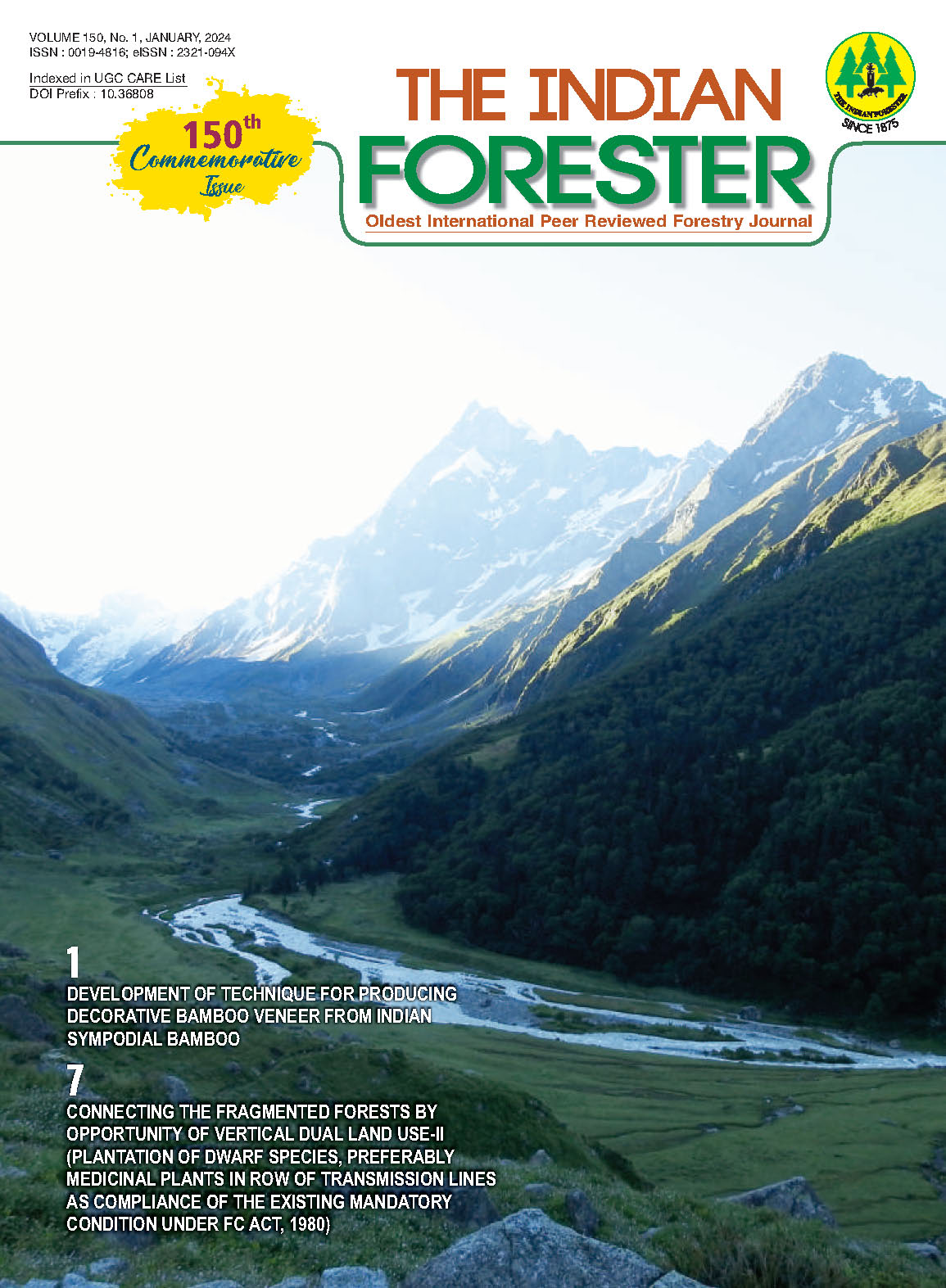Genetic Variability and Heritability for Growth and Quality Traits in Casuarina under Semi-Arid Region of Punjab
DOI:
https://doi.org/10.36808/if/2024/v150i1/169856Keywords:
Casuarina, Clonal Evaluation, Genetic Parameters, Path Analysis.Abstract
Clonal evaluation experiment of Casuarina junghuhniana was established at Research Farm, Bathinda. At the age of 3¼ years, growth parameters and stem parameters axis persistence and straightness were recorded. Phenotypic coefficient of variation, genotypic coefficient of variation, heritability and genetic gains were also observed. Maximum PCV and GCV was recorded in tree volume followed by branch thickness. Heritability was recorded maximum for branch thickness (77.93%) followed by tree height (76.25%) and stem volume (70.45%) tree stem volume (21.99%) and crown spread (21.99%). High significant phenotypic correlation was found for tree stem volume with tree height (0. 0.9400) followed by tree stem volume with diameter (0.9328), and diameter and tree height (0.8821). Path analysis demonstrated the direct and indirect effect of the traits on the performance of tree stem volume. The maximum direct effect was registered for diameter at breast height (0.5942) and the least value for direct effect was recorded for crown spread (-0.1417) while the indirect effect was registered maximum by tree height for diameter at breast height (0.5241) and the lowest indirect effect was registered by diameter for number of branches diameter (-0.1816).References
Blada I., Tanasie S., Dinu C. and Bratu I. (2014). Growth, straightness and survival at age 32 in a Pinus strobus × P. wallichiana F. hybrid population. Annls For. Res., 56: 269-82. 1
Burton G.W. (1952). Quantitative inheritance in grasses, Proc. 7th Intl. Grassland Congress, 1: 277-283.
Garg R.K. and Kaushik N. (2021). Heritability, genetic gain and correlation among progenies of Pongamia pinnata (L.) Pierre for morphological traits. Range Mgt Agrofor., 42(1): 175-80.
Gera M., Gera N. and Aggarwal R. (1999). Path analysis in Dalbergia sissoo Roxb., Indian Forester, 125 (7): 660-664.
Johnson H.W., Robinson H.F. and Comstock R.E. (1955). Estimates of genetic and environmental variability in soybeans. Agron J., 47: 314-18.
Kumar R. (2012). Genetic variability and association studies in Pongamiapinnata(L.)Pierre.RangeMgtAgrofor.,33(2): 129-132
Kumar R. and Bangarwa K.S. (2010). Estimates of components of variance, heritability, genetic advance and correlation among morphological characters of Eucalyptus tereticornis clones. Indian J. For., 33(2): 161-165.
Kumar R. (2014). Seed source variation and character association studies for seed and seedling traits in Pongamia pinnata (L.) Pierre. Indian J. For., 37(3): 255-258.
Luechanimitchit P., Luangviriyasaenga V., Laosakula S., Pinyopusarerkb K. and Bush V. (2017). Genetic parameter estimates for growth, stem-form and branching traits of Casuarina junghuhniana clones grown in Thailand. Forest Ecol Mgmt., 404: 251-57.
Lush J.L. (1949) Hritability of quantitative characters in farm animals. Hereditas, 35, 356-375. doi:10.1111/j.1601-5223.1949.tb03347.x
Ma N., Zhang Y., Zang C.L. and Wang R.K. (2014). Provenance trial and early selection of Casuarina glauca in Hainan. For Res., 27(3): 435-40.
Moezal P.G.V.D., Walton C.S., Pearce-Pinto G.V.N. and Bell D.T. (1989). Screening for salinity and waterlogged tolerance in five Casuarina spp. Lnd. scape and urb. plan., 17: 331-337.
Nicodemus A. (2009). Casuarina – A Guide for Cultivation. Institute of Forest Genetics and tree Breeding (Indian Council of Forestry Research and Education) Coimbatore, India, 16-18.
Parrotta J.A. and Baker D.D. (1994). application of N-15-enrichment methodologies to estimate nitrogen-fixation in Casuarina-equisetifolia. Can. J. For. Res., 24: 201-207.
Rawat G.S., Singh N.B., Gupta R.K., Singh K. and Sharma S.D. (2001). Clonal evaluation of Poplar (Populus deltoides Bartr.) in Eastern Uttar Pradesh. I - Nursery testing., Indian Forester, 127(1):70-80
Turnbull J.W. (1990). Taxonomy and genetic variation in casuarinas. In Advances in Casuarina Research and Utilization. Edited by M.H. El-Lakany, J.W Turnbull and J.L. Brewbaker. Desert Development Centre AUC, Cairo. 1 - 11.
Viswanath S., Manivahakam P. and George M. (2001). Casuarina equisetifolia in agroforestry practices. In: Gurumurthi K, Nicodemus A, Siddappa (ed) Pp. 187-192 Casuarina Improvement and Utilization, Institute of Forest Genetics and Tree Breeding, Coimbatore.
Downloads
Downloads
Published
How to Cite
Issue
Section
License
Unless otherwise stated, copyright or similar rights in all materials presented on the site, including graphical images, are owned by Indian Forester.





